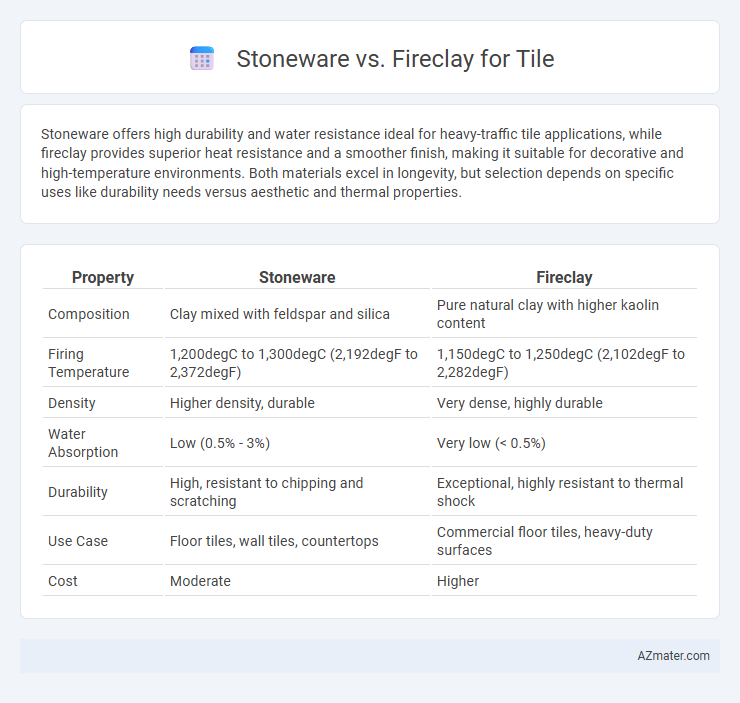Stoneware offers high durability and water resistance ideal for heavy-traffic tile applications, while fireclay provides superior heat resistance and a smoother finish, making it suitable for decorative and high-temperature environments. Both materials excel in longevity, but selection depends on specific uses like durability needs versus aesthetic and thermal properties.
Table of Comparison
| Property | Stoneware | Fireclay |
|---|---|---|
| Composition | Clay mixed with feldspar and silica | Pure natural clay with higher kaolin content |
| Firing Temperature | 1,200degC to 1,300degC (2,192degF to 2,372degF) | 1,150degC to 1,250degC (2,102degF to 2,282degF) |
| Density | Higher density, durable | Very dense, highly durable |
| Water Absorption | Low (0.5% - 3%) | Very low (< 0.5%) |
| Durability | High, resistant to chipping and scratching | Exceptional, highly resistant to thermal shock |
| Use Case | Floor tiles, wall tiles, countertops | Commercial floor tiles, heavy-duty surfaces |
| Cost | Moderate | Higher |
Introduction to Stoneware and Fireclay Tiles
Stoneware tiles are dense, durable ceramic tiles fired at high temperatures, offering excellent resistance to moisture and wear, making them ideal for heavy-traffic areas. Fireclay tiles, made from a refined clay mixture fired at ultra-high temperatures, provide exceptional strength and a smooth, glass-like finish often used in decorative tile work. Both materials deliver long-lasting performance, with stoneware favored for practicality and fireclay prized for its aesthetic appeal and resistance to chipping.
Composition and Raw Materials
Stoneware tiles are primarily composed of natural clay mixed with feldspar, quartz, and other minerals, which are fired at high temperatures between 1200degC and 1300degC to achieve durability and water resistance. Fireclay tiles incorporate a higher concentration of fire-resistant clay, including kaolin and alumina, providing enhanced heat resistance and toughness due to their dense, refractory composition. The raw materials for stoneware emphasize strength and impermeability, while fireclay focuses on thermal stability and mechanical strength, making their compositions distinctly suited for different tile applications.
Manufacturing Process Comparison
Stoneware tiles are manufactured by firing natural clay at high temperatures between 1,100degC and 1,300degC, resulting in a dense, durable material with low porosity. Fireclay tiles undergo a similar high-temperature firing process but utilize a specific type of clay rich in alumina and silica, fired at even higher temperatures around 1,200degC to 1,400degC, which enhances their strength and resistance to thermal shock. The manufacturing precision in fireclay tiles often includes extended firing times and refined clay composition, producing a more vitrified and robust tile compared to standard stoneware.
Durability and Strength
Stoneware tiles offer excellent durability and resistance to wear, making them ideal for high-traffic areas due to their dense, non-porous composition. Fireclay tiles are exceptionally strong with a higher resistance to thermal shock and chipping, benefiting from their unique clay blend and high firing temperatures. Both materials provide robust strength, but fireclay is often preferred for its superior toughness and longer lifespan in demanding environments.
Water Absorption and Resistance
Stoneware tiles exhibit low water absorption rates, typically below 0.5%, making them highly resistant to moisture and suitable for both indoor and outdoor applications. Fireclay tiles, known for their superior density, often achieve water absorption rates under 0.3%, providing exceptional resistance to water penetration and chemical damage. Both materials offer durable, water-resistant surfaces, but fireclay's lower porosity enhances longevity in high-moisture environments.
Aesthetic Variations and Finishes
Stoneware tiles offer a wide range of natural, earthy shades with matte and satin finishes, providing a rustic and organic aesthetic ideal for traditional and modern spaces. Fireclay tiles are known for their vibrant colors and highly customizable glazed finishes, delivering a glossy, smooth surface that enhances brightness and visual depth in design. The choice between stoneware and fireclay depends on the desired texture and finish, with stoneware emphasizing warmth and durability and fireclay prioritizing vivid color and finely detailed patterns.
Cost and Price Differences
Stoneware tiles are generally more affordable than fireclay tiles due to the lower production costs and wider availability of raw materials. Fireclay tiles, made from a higher-quality, denser clay fired at higher temperatures, command a premium price reflecting their durability and aesthetic appeal. The price difference can range from 20% to 50%, with fireclay tiles often considered a long-term investment for their resistance to wear and unique texture.
Suitable Applications and Use Cases
Stoneware tiles, known for their durability and water resistance, are ideal for indoor flooring, bathroom walls, and kitchen backsplashes where moderate wear and moisture exposure occur. Fireclay tiles, with superior heat resistance and non-porous surface, excel in high-temperature environments like fireplaces, ovens, and outdoor patios. Both materials suit residential and commercial spaces, but fireclay's enhanced thermal properties make it preferred for areas with extreme heat or heavy chemical exposure.
Maintenance and Care Requirements
Stoneware tiles require moderate maintenance with regular cleaning using pH-neutral detergents to prevent surface wear and maintain their natural finish. Fireclay tiles are highly durable and stain-resistant, demanding minimal upkeep beyond routine wiping and occasional sealing to preserve their glossy surface and prevent moisture penetration. Both materials benefit from prompt spill cleanup and periodic grout sealing to ensure longevity and maintain aesthetic appeal.
Environmental Impact and Sustainability
Stoneware tiles offer durability and low porosity, reducing the need for frequent replacements and minimizing environmental waste. Fireclay tiles are manufactured from natural, abundant clay materials with lower firing temperatures, resulting in a reduced carbon footprint during production. Both materials support sustainability through their long lifespan and recyclability, but fireclay's eco-friendly sourcing and energy-efficient processing make it a greener choice overall.

Infographic: Stoneware vs Fireclay for Tile
 azmater.com
azmater.com